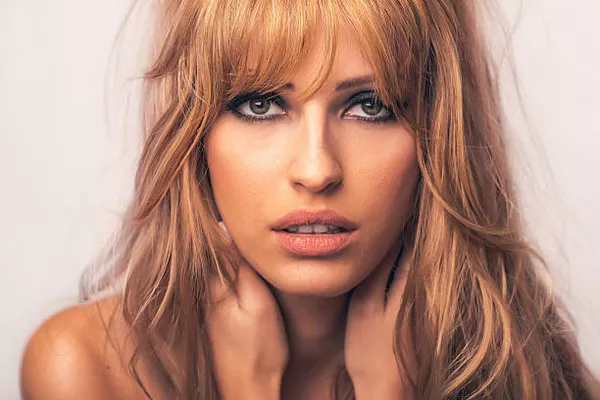Curtain bangs are a versatile and stylish addition to any hairstyle, especially for those with naturally curly hair. This guide will provide detailed suggestions, reasons, and analysis to help you achieve the perfect look.
Understanding Curtain Bangs
What Are Curtain Bangs?
Curtain bangs are a type of fringe that frames the face on both sides, resembling an open curtain. They are typically parted down the middle or slightly off-center and can be worn with various hair lengths and textures.
Why Curtain Bangs for Curly Hair?
Curtain bangs complement curly hair by enhancing its natural volume and texture. They can soften facial features, add a youthful touch, and provide a chic, effortless look.
Preparing for Curtain Bangs
Consultation with a Professional Stylist
Before cutting curtain bangs, it’s essential to consult with a professional stylist. They can assess your hair type, face shape, and personal style preferences to determine the most flattering bang style for you.
Choosing the Right Length and Shape
For curly hair, the length and shape of curtain bangs are crucial. Longer bangs tend to blend better with curls and require less maintenance. Discuss with your stylist whether a blunt or feathered edge suits your look best.
Cutting Curtain Bangs for Curly Hair
Sectioning the Hair
Proper sectioning is vital for even and balanced bangs. Use clips to separate the front section of your hair, ensuring it’s evenly divided down the middle.
Cutting Techniques
Cutting curly hair requires a different approach than straight hair. Stylists often use the “twist and cut” technique or dry cutting to account for the natural shrinkage of curls. This helps avoid overly short bangs.
Blending with the Rest of the Hair
To create a seamless transition between the bangs and the rest of the hair, blending is essential. This can be achieved by cutting at an angle or using thinning shears to soften the edges.
Styling Curtain Bangs
Daily Styling Routine
Establishing a daily styling routine will help maintain the shape and bounce of your curtain bangs. Here are the key steps:
Moisturize and Detangle: Start with a leave-in conditioner or curl cream to hydrate your curls and reduce frizz. Gently detangle your hair using a wide-tooth comb or fingers.
Define Curls: Apply a curl-defining product, such as a mousse or gel, to enhance the shape of your bangs.
Drying Techniques: Air-drying is the best option for curly hair to preserve its natural texture. Alternatively, use a diffuser attachment on your hairdryer to minimize frizz and add volume.
Parting and Shaping: Use your fingers or a comb to part your bangs down the middle or slightly off-center. Adjust the shape by scrunching or twisting small sections.
Heat Styling Options
While it’s best to avoid excessive heat on curly hair, occasional heat styling can offer versatility:
Blow Drying: Use a round brush to blow dry your bangs for a smoother look. Ensure your hair is adequately protected with a heat protectant spray.
Curling Iron: For more defined curls, use a small-barrel curling iron. Wrap small sections around the barrel and hold for a few seconds.
Maintaining Volume and Bounce
To maintain the volume and bounce of your curtain bangs:
Pineapple Method: At night, gather your bangs and top section of hair into a loose ponytail on top of your head to preserve curls and prevent flattening.
Refresh Curls: In the morning, use a water spray bottle to lightly dampen your bangs and reapply a curl-defining product.
See Also: How To Flat Iron Curl Weave
Troubleshooting Common Issues
Dealing with Frizz
Frizz is a common challenge with curly hair. Combat it by:
Using Anti-Frizz Products: Incorporate anti-frizz serums or creams into your routine.
Avoiding Humidity: Protect your hair from humidity by wearing a hat or using a weather-appropriate product.
Managing Uneven Growth
Curtain bangs may grow unevenly, leading to an imbalanced look. To manage this:
Regular Trims: Schedule regular trims every 4-6 weeks to maintain the desired length and shape.
At-Home Maintenance: Learn to do minor trims at home, if comfortable, using sharp, professional scissors.
Handling Second-Day Hair
Curly hair often looks best on the first day after washing, but you can still manage second-day hair effectively:
Dry Shampoo: Use dry shampoo to absorb excess oil and refresh your bangs.
Re-Curling: Lightly re-curl any sections that have lost their shape with a small-barrel curling iron.
Long-Term Care for Curtain Bangs
Hydration and Moisture
Curly hair needs consistent hydration. Use deep conditioning treatments and hydrating masks weekly to maintain moisture levels.
Protective Styles
Protective styles can help maintain the integrity of your curls and bangs. Consider styles like braids or twists when you want to give your hair a break.
Regular Salon Visits
Regular visits to your stylist will ensure your curtain bangs stay in shape and your curls remain healthy. Professional treatments and trims are essential for long-term hair health.
Conclusion
Styling curtain bangs with naturally curly hair involves understanding your unique hair texture and following specific techniques to achieve the desired look. With the right preparation, cutting methods, and styling routines, you can enjoy beautiful, bouncy curtain bangs that complement your curly hair perfectly. Regular maintenance and hydration will ensure your bangs look their best every day.


